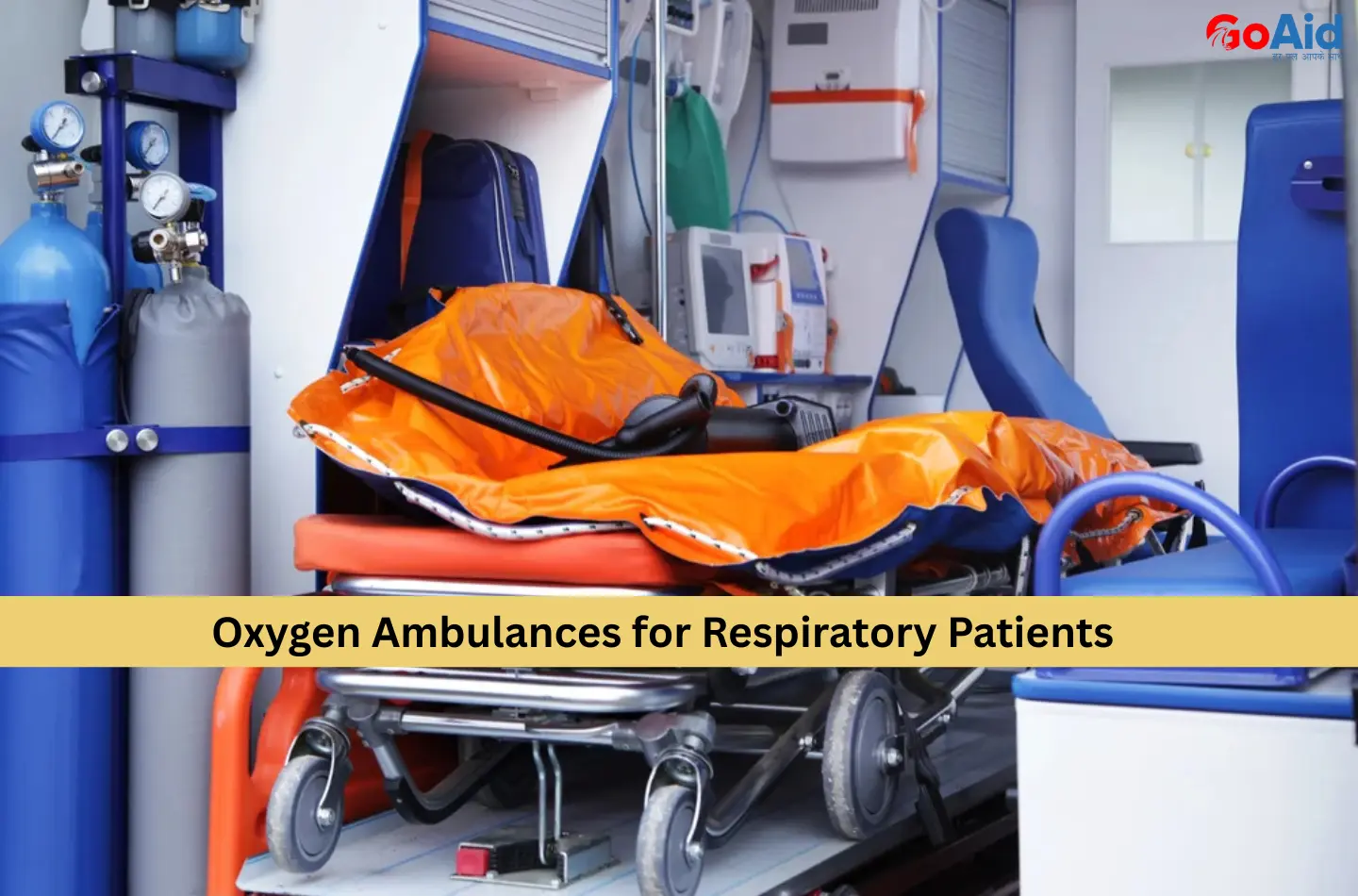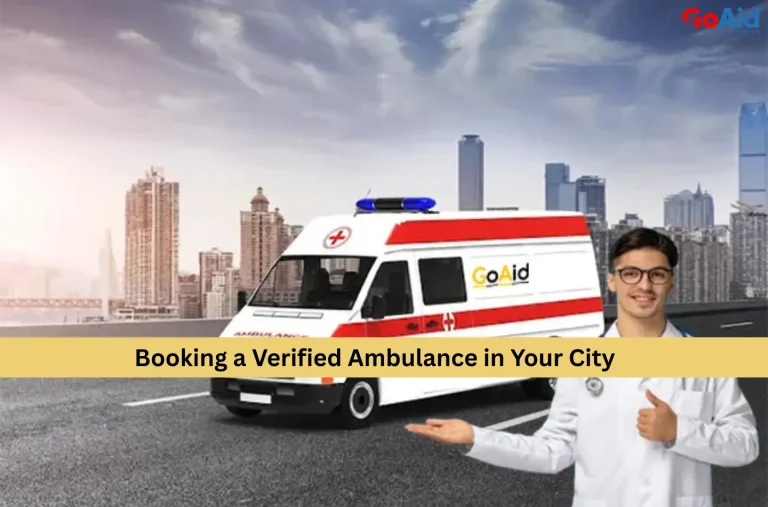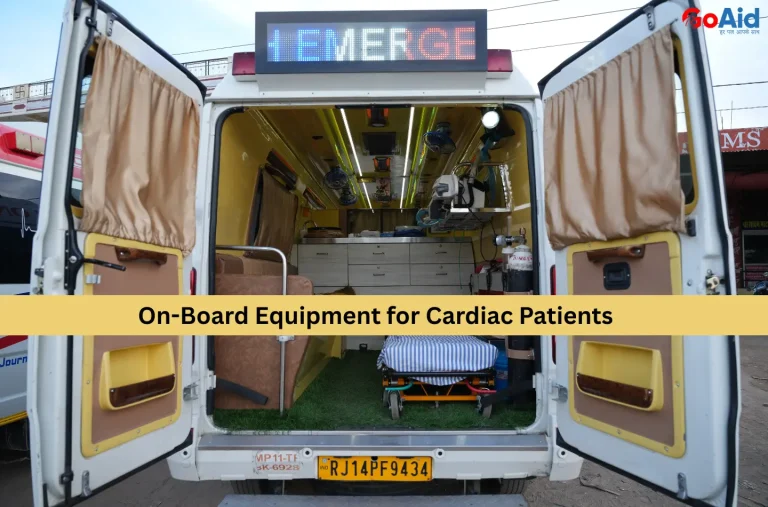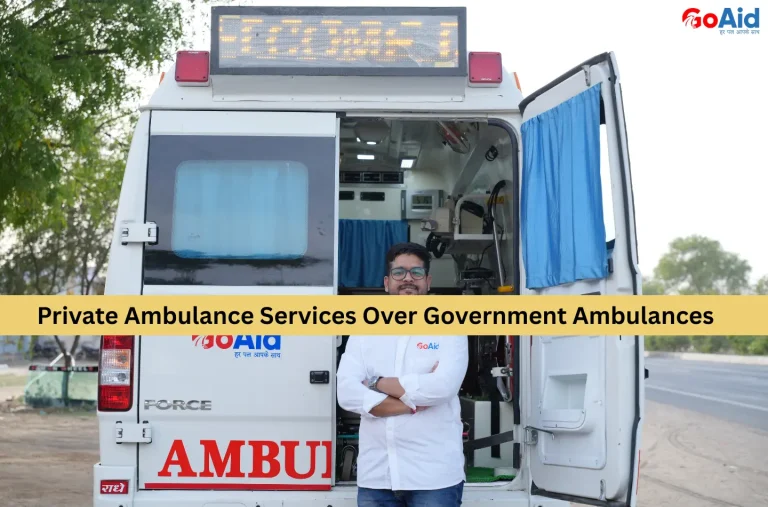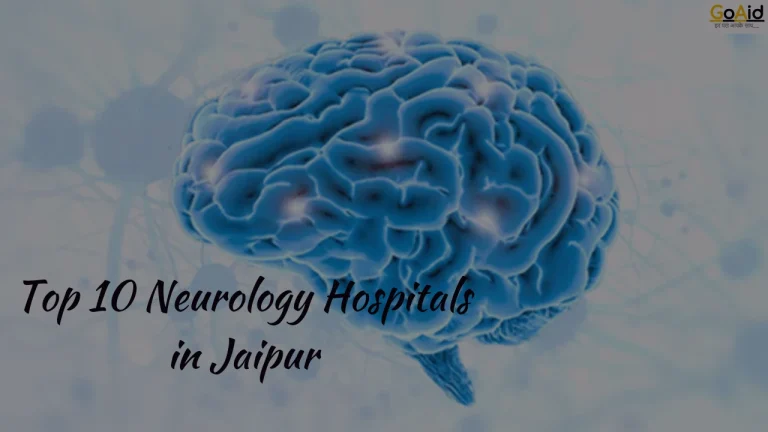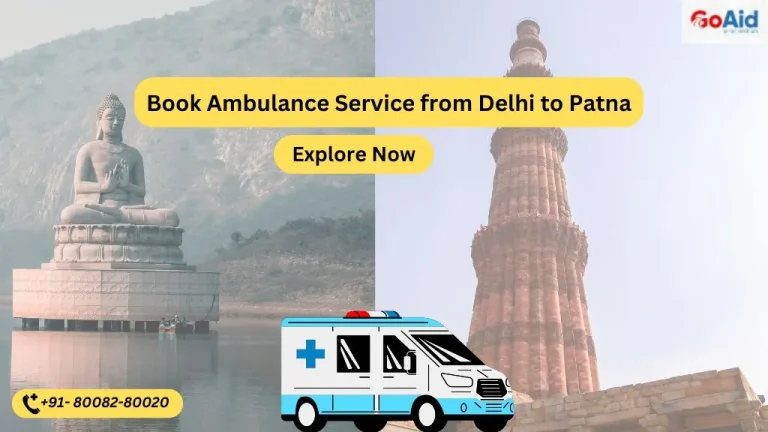Respiratory patients, especially those with COPD, asthma, or sudden breathing difficulties, require immediate and specialized medical support during transport. Ordinary vehicles or standard ambulances may not provide the life-saving oxygen supply and monitoring they need. This makes timely access to oxygen-supported ambulances critical.
This is why, in this blog we have provided you with all the details about why respiratory patients need oxygen support, how oxygen ambulances help in emergencies, key equipment and ventilator support, trained paramedic assistance, fast response times, and why choosing verified GoAid oxygen ambulance services ensures safe and reliable care. Do you want to know all these information in detail? then read our blog to the end.
So, lets start-
Why Do Respiratory Patients Need Oxygen Support During Transport?
Respiratory patients. This includes those with COPD, asthma, pneumonia, or COVID-19 complications, often experience low oxygen levels, labored breathing, and unstable vitals. Transporting such patients without oxygen can worsen hypoxia, increase cardiac strain, and lead to life-threatening emergencies.
Continuous oxygen support during transit ensures sufficient oxygen saturation, stabilizes breathing, and prevents sudden deterioration. Oxygen-supported ambulances provide ventilators, oxygen cylinders, and monitoring devices. This allows paramedics to adjust oxygen flow as needed.
Additionally, trained EMTs manage airway complications, monitor vitals, and respond promptly to any respiratory distress. Timely intervention en route reduces the risk of severe complications and improves outcomes upon arrival at hospitals.┬Ā
Using professional oxygen ambulance services like GoAid ensures patients receive continuous, safe, and monitored oxygen therapy. This makes the transfer both secure and medically effective, especially during long-distance or critical emergency transports.
How Does an Oxygen Ambulance Help in Breathing Difficulty Cases?
Oxygen ambulances are designed to provide immediate respiratory support for patients facing breathing difficulties, hypoxia, or severe lung conditions. Equipped with oxygen cylinders, ventilators, and pulse oximeters, these ambulances allow continuous monitoring and intervention during transport.
Trained EMTs administer oxygen, adjust flow rates, and manage ventilator settings according to patient needs. In acute situations like COPD exacerbations or respiratory distress, timely oxygen supply prevents oxygen deprivation, stabilizes heart rate, and reduces complications.
Paramedics can also perform airway management, suctioning, and provide emergency medications while en route. Oxygen ambulances ensure uninterrupted communication with hospitals. This allows advanced preparation for critical care.┬Ā
By combining equipment, monitoring, and professional care, oxygen-supported ambulances significantly reduce risks for respiratory patients. This makes transfers safe and efficient, especially in emergencies where even a few minutes of delay can escalate the condition.
Services like GoAid specialize in rapid oxygen ambulance deployment for city-wide and intercity transfers.
What Makes GoAidŌĆÖs Oxygen Ambulance Services Reliable?
Choosing GoAid ensures professional and dependable oxygen ambulance services across cities. This provides advanced care for respiratory patients during emergencies.
1. Trained Paramedics for Respiratory Care
GoAid deploys certified EMTs skilled in oxygen therapy, ventilator management, and monitoring breathing difficulties. This ensures safe patient transfer.
2. Advanced Oxygen Equipment
Ambulances carry high-flow oxygen systems, concentrators, and ventilators for continuous respiratory support during short or long transfers.
3. Continuous Vital Monitoring
Paramedics monitor oxygen saturation, heart rate, and blood pressure to adjust treatment and prevent complications in transit.
4. Rapid Response Time
GoAid ensures fast ambulance arrival. This minimizes delays for respiratory emergencies where every minute is critical.
5. Multiple Ambulance Types
Options include BLS, ALS, ICU, and ventilator-equipped ambulances tailored for specific respiratory needs.
6. National and City-Wide Coverage
GoAid offers oxygen ambulance services across cities and states. This ensures access wherever patients require emergency transport.
7. Transparent Pricing & Government Approval
Charges are affordable, transparent, and follow approved standards, guaranteeing no hidden costs during emergency care.
8. Real-Time Tracking & Communication
Families can track ambulances, stay informed, and communicate with paramedics en route for peace of mind.
9. Pre-Hospital Stabilization
Patients receive immediate oxygen support, airway management, and monitoring. This reduces deterioration before hospital arrival.
10. Commitment to Safety & Hygiene
Ambulances are sanitized, well-maintained, and equipped with safety devices. This ensures infection-free and secure patient transfers.
How Oxygen Levels Are Monitored During Patient Transfer?
During patient transfer, oxygen saturation is continuously monitored using pulse oximeters and blood gas analysis when necessary. Paramedics track oxygen levels, heart rate, and respiratory rate to adjust supplemental oxygen in real time.
Ventilators or high-flow oxygen systems provide precise delivery. This ensures stable saturation. Continuous monitoring helps detect early signs of hypoxia or deterioration. This allows immediate intervention. EMTs document readings and communicate with hospitals to prepare for advanced care on arrival.
This proactive approach prevents complications, maintains patient stability, and ensures safe transfer, especially for critical respiratory patients requiring constant oxygen support.
What Role Does Ventilator Support Play in Critical Cases?
Ventilator support is vital for patients unable to breathe effectively on their own. This includes severe COPD, ARDS, or respiratory failure cases. It ensures oxygenation, stabilizes breathing, and prevents complications during transport.
1. Ensures Continuous Oxygen Delivery
Ventilators supply a steady, controlled oxygen flow to critical patients, preventing hypoxia and maintaining adequate oxygen saturation throughout the emergency transfer.
2. Supports Mechanical Breathing
Patients with weakened lungs or respiratory muscles receive mechanical assistance. This reduces the effort required to breathe and preventing exhaustion during transport.
3. Stabilizes Carbon Dioxide Levels
Ventilator control helps remove excess COŌéé efficiently, preventing dangerous imbalances that could compromise cardiac and neurological functions.
4. Adjustable Oxygen Concentration
Paramedics can fine-tune oxygen levels as per patient requirements. This ensures precise therapy according to medical condition and severity.
5. Maintains Respiratory Rate
The ventilator regulates breathing frequency, preventing hyperventilation or hypoventilation and keeping the patient stable en route.
6. Enables Airway Management
Critical patients with airway obstruction benefit from ventilator support combined with advanced airway interventions like intubation.
7. Reduces Complications During Transport
Continuous ventilation minimizes deterioration risk. This ensures safe transit to the hospital without emergencies en route.
8. Allows Paramedics to Administer Other Treatments
While ventilators handle breathing, EMTs focus on medications, monitoring vitals, and stabilizing the patient efficiently.
9. Critical for Long-Distance Transfers
Ventilators provide continuous life-support for extended transport. This ensures stability and safety during intercity or prolonged transfers.
10. Enhances Survival Chances
Timely ventilator use significantly increases recovery probability and reduces mortality in critical respiratory emergencies.
Why COPD and Asthma Patients Require Special Ambulances?
Patients with COPD or asthma are highly sensitive to oxygen levels and environmental triggers. Specialized ambulances ensure oxygen support, monitoring, and emergency care during transfer.
1. Oxygen Support Availability
Special ambulances carry high-flow oxygen cylinders and concentrators to maintain oxygen saturation, which is critical for COPD and asthma patients.
2. Trained Paramedics
Certified EMTs skilled in respiratory emergencies can manage exacerbations, bronchospasms, and sudden breathing difficulties safely.
3. Ventilator Readiness
Critical patients may need ventilator support during transport, which is available only in specialized ambulances.
4. Continuous Monitoring
Pulse oximeters, cardiac monitors, and respiratory rate tracking allow real-time assessment and quick intervention en route.
5. Rapid Response
Specialized ambulances ensure fast arrival at the patientŌĆÖs location, crucial for preventing deterioration during acute respiratory attacks.
6. Emergency Medication Administration
Paramedics can administer bronchodilators, corticosteroids, or other emergency drugs immediately during transport.
7. Airway Management
Proper airway care techniques prevent hypoxia, respiratory distress, and complications during transit.
8. Infection Control
Sanitized and sterile ambulances minimize exposure to infections that could worsen respiratory conditions.
9. Climate Control
Temperature and humidity inside the ambulance are regulated to prevent triggers that worsen COPD or asthma symptoms.
10. Safe Transport Over Long Distances
Specialized vehicles ensure oxygen stability, monitoring, and emergency care. This makes intercity transfers safe for vulnerable respiratory patients.
What Equipment Should an Oxygen-Supported Ambulance Have?
Oxygen-supported ambulances must be equipped with specialized medical devices to manage respiratory emergencies efficiently. This ensures patients receive continuous care, monitoring, and life-saving interventions during transport.
1. Oxygen Cylinders & Concentrators
High-flow oxygen cylinders and concentrators provide continuous oxygen supply to patients. This maintains safe saturation levels during transit.
2. Ventilators
Portable ventilators support patients unable to breathe independently. This allows precise control of oxygen delivery and respiratory rate.
3. Pulse Oximeters
Pulse oximeters monitor oxygen saturation continuously, alerting paramedics to any sudden drops requiring immediate intervention.
4. ECG Monitors
ECG monitors track heart function, which is crucial for respiratory patients prone to cardiac complications due to low oxygen levels.
5. Suction Devices
Suction machines help clear airways of secretions or mucus, preventing obstruction and ensuring adequate ventilation.
6. Emergency Drug Kits
Ambulances carry bronchodilators, corticosteroids, epinephrine, and other emergency medications for immediate treatment during respiratory distress.
7. Nebulizers
Nebulizers allow rapid administration of inhaled medications. This reduces bronchospasms and easing breathing difficulties en route.
8. Stretchers & Immobilization Equipment
Adjustable stretchers and restraints ensure safe patient transport while providing comfort and stability during emergency transfers.
How Trained Paramedics Manage Respiratory Emergencies?
Certified paramedics are essential for handling breathing emergencies. This ensures patients remain stable, oxygenated, and monitored until hospital arrival.
1. Continuous Oxygen Administration
Paramedics adjust oxygen flow based on real-time monitoring. This ensures the patient maintains adequate saturation.
2. Ventilator Management
They operate portable ventilators for patients unable to breathe independently, regulating respiratory rate and oxygen levels.
3. Airway Management
Trained EMTs perform suctioning, intubation, and airway clearance to prevent obstruction and respiratory failure.
4. Medication Delivery
Emergency drugs like bronchodilators, corticosteroids, or epinephrine are administered according to protocols for immediate relief.
5. Vital Sign Monitoring
Paramedics track oxygen saturation, pulse, respiratory rate, and blood pressure continuously during transit.
6. Rapid Assessment
Quick evaluation of patient condition allows prompt intervention and pre-hospital stabilization.
7. Communication with Hospitals
They relay patient status to hospitals for advanced preparation upon arrival.
8. Emergency Interventions
Paramedics manage acute exacerbations, cardiac complications, or hypoxia en route effectively.
9. Patient Comfort & Safety
They ensure proper positioning, immobilization, and stress-free handling to reduce panic or further complications.
10. Adapting to Changing Conditions
Paramedics adjust oxygen, ventilator settings, and treatment protocols dynamically in response to patient condition fluctuations.
How Quickly Can Oxygen Ambulances Reach Your Location?
Oxygen ambulances are designed for rapid deployment, especially for critical respiratory emergencies. Verified services like GoAid maintain strategically located fleets across cities to ensure quick response times.
On average, GoAid ambulances reach most urban locations within 10ŌĆō15 minutes, depending on traffic conditions and distance. Emergency calls are prioritized, and trained dispatch teams coordinate real-time ambulance routing for the fastest arrival.
Rapid response is crucial for patients experiencing severe breathing difficulties, COPD exacerbations, or hypoxia. Immediate oxygen therapy and paramedic intervention en route stabilize patients, prevent complications, and significantly increase survival chances. Using a reliable service like GoAid guarantees both speed and professional care.
Why Choosing Verified Oxygen Ambulance Services Matters?
Selecting a verified ambulance ensures professional, safe, and effective respiratory emergency transport for patients who need continuous oxygen support.
1. Certified Paramedics
Verified services provide EMTs trained in oxygen therapy, ventilator use, and emergency respiratory care.
2. Fully Equipped Vehicles
Ambulances carry ventilators, oxygen cylinders, suction machines, and monitoring devices for critical patient care.
3. Fast Response Times
Verified providers maintain strategically positioned fleets for rapid deployment during emergencies.
4. Government-Approved Charges
Pricing is transparent, avoiding hidden costs or surprise fees during urgent situations.
5. Continuous Patient Monitoring
Paramedics track vitals and oxygen saturation in real-time to prevent deterioration during transit.
6. Safe and Sanitized Ambulances
Vehicles are maintained to ensure hygiene and reduce infection risk for vulnerable respiratory patients.
7. Advanced Communication Systems
Real-time hospital updates allow preparation for patient arrival and ensure uninterrupted care.
8. Specialized Ambulance Types
Options include ventilator-supported, ICU, and BLS ambulances tailored to patient needs.
9. Pre-Hospital Stabilization
Immediate oxygen support, airway management, and medication administration stabilize patients before hospital care.
10. Nationwide Coverage
Verified services like GoAid operate across multiple cities. This ensures access to oxygen ambulances wherever needed.
Conclusion
In conclusion, we have provided all the information about oxygen-supported ambulance services for respiratory patients. From understanding the need for oxygen during transport, the critical role of ventilators, and trained paramedics to the advantages of verified providers like GoAid, families can ensure safe, rapid, and professional emergency care.┬Ā
Choosing GoAid guarantees quick response, advanced life-support equipment, continuous monitoring, and expert care. This makes patient transfers safer and improving outcomes significantly. Verified oxygen ambulances are essential for COPD, asthma, and critical respiratory patients during emergencies across cities.
FAQs
Q1: How can I book an oxygen-supported ambulance quickly?
A: You can book a verified oxygen ambulance with GoAid via their app or by calling 8008280020. This ensures rapid deployment and professional respiratory care.
Q2: What equipment do oxygen ambulances carry for respiratory patients?
A: Oxygen ambulances include ventilators, oxygen cylinders, pulse oximeters, suction machines, nebulizers, ECG monitors, and emergency drug kits to manage breathing difficulties safely.
Q3: Why are trained paramedics crucial in oxygen ambulance services?
A: EMTs provide real-time monitoring, ventilator management, airway interventions, and emergency medication administration. This stabilizes respiratory patients during transport for safe hospital arrival.
Q4: How fast can GoAid oxygen ambulances reach patients?
A: GoAid ambulances typically arrive within 10ŌĆō15 minutes in urban areas. This ensures immediate oxygen support and emergency care for respiratory patients.
Q5: Can oxygen ambulances handle critical COPD or asthma cases?
A: Yes, specialized ambulances with trained paramedics, ventilators, and continuous monitoring provide safe and effective transfer for severe COPD and asthma emergencies.

